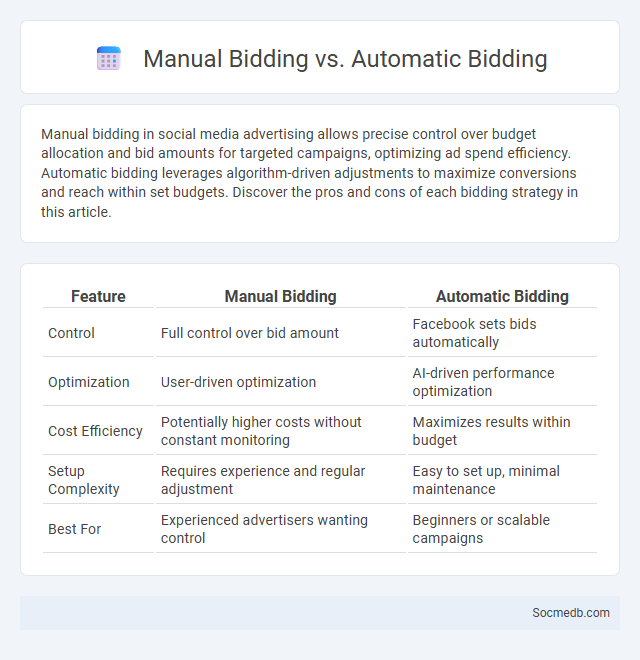
Photo illustration: Manual Bidding vs Automatic Bidding
Manual bidding in social media advertising allows precise control over budget allocation and bid amounts for targeted campaigns, optimizing ad spend efficiency. Automatic bidding leverages algorithm-driven adjustments to maximize conversions and reach within set budgets. Discover the pros and cons of each bidding strategy in this article.
Table of Comparison
| Feature | Manual Bidding | Automatic Bidding |
|---|---|---|
| Control | Full control over bid amount | Facebook sets bids automatically |
| Optimization | User-driven optimization | AI-driven performance optimization |
| Cost Efficiency | Potentially higher costs without constant monitoring | Maximizes results within budget |
| Setup Complexity | Requires experience and regular adjustment | Easy to set up, minimal maintenance |
| Best For | Experienced advertisers wanting control | Beginners or scalable campaigns |
Understanding Manual Bidding
Manual bidding on social media platforms allows advertisers to set specific cost-per-click (CPC) or cost-per-impression (CPM) limits, providing greater control over ad spend and campaign performance. By optimizing bids based on audience behavior, time of day, and ad relevance, marketers can enhance ROI and target their desired demographics more effectively. Understanding key metrics, such as bid cap and bid strategy, is crucial to fine-tuning manual bidding for successful social media advertising campaigns.
What Is Automatic Bidding?
Automatic bidding is a social media advertising strategy where the platform's algorithm optimizes your ad spend to achieve specific goals, such as maximizing clicks, conversions, or impressions. This method uses machine learning to adjust bids in real time, ensuring efficient budget allocation based on audience behavior and competition. You benefit from reduced manual effort and improved campaign performance by leveraging automatic bidding in your social media ads.
The Ad Auction Explained
The ad auction is the process used by social media platforms like Facebook, Instagram, and Twitter to determine which ads to show users based on relevance, bid amount, and estimated action rates. Your ad's success depends on winning this auction by having a compelling combination of bid, ad quality, and user engagement prediction. Understanding how the ad auction works helps you optimize campaigns to reach your target audience more effectively and maximize return on investment.
Key Differences: Manual vs Automatic Bidding
Manual bidding on social media allows you to control the maximum cost per click (CPC) or cost per impression (CPM), tailoring your budget to specific campaign goals and audience segments. Automatic bidding uses algorithms to optimize ad delivery in real-time, aiming to maximize results within your budget by adjusting bids based on performance data. Understanding the key differences between manual and automatic bidding helps you choose the best strategy to enhance your ad efficiency and ROI.
Pros and Cons of Manual Bidding
Manual bidding in social media advertising offers precise control over your campaign budget and allows for customized bid adjustments based on performance data, potentially maximizing ROI. However, it requires constant monitoring and expertise to avoid overspending or underbidding, which can lead to reduced ad visibility or wasted budget. Understanding the trade-offs between control and time investment helps you optimize your social media ad strategy effectively.
Pros and Cons of Automatic Bidding
Automatic bidding on social media platforms streamlines ad budget management by using algorithms to optimize your bids for desired outcomes like clicks, impressions, or conversions, ensuring efficient use of your budget. However, the lack of manual control may lead to overspending or suboptimal targeting without constant monitoring. Understanding these pros and cons helps you leverage automatic bidding to maximize your campaign's effectiveness while mitigating potential risks.
How Ad Auctions Influence Bidding Strategies
Ad auctions on social media platforms directly impact your bidding strategies by determining how much you pay for ad placements based on competition and relevance scores. Understanding the auction dynamics, including bid amount, ad quality, and expected user engagement, allows you to optimize bids for better cost efficiency and improved ad performance. Tailoring your strategy to prioritize higher quality scores and audience targeting can significantly increase the return on your social media advertising investment.
When to Choose Manual Bidding
Manual bidding is ideal when you want precise control over your ad spend and campaign performance on social media platforms like Facebook or Instagram. You can optimize bids based on specific audience segments, time of day, or device type to maximize return on investment (ROI). Choosing manual bidding allows your strategy to align closely with fluctuating market conditions and competitive landscapes.
When to Use Automatic Bidding
Automatic bidding is most effective during campaigns with limited time for manual adjustments or when targeting complex audience segments across social media platforms like Facebook and Instagram. It enables optimized ad delivery by leveraging machine learning to allocate budgets efficiently based on real-time conversion data. Marketers benefit from automatic bidding when aiming to maximize return on ad spend (ROAS) or increase conversions without constant campaign management.
Optimizing Bidding Strategies for Ad Auctions
Optimizing bidding strategies in social media ad auctions enhances your campaign's efficiency by targeting specific audience segments and maximizing return on investment. Leveraging machine learning algorithms can automate bid adjustments based on real-time auction dynamics and competitor behavior. Your ability to analyze performance metrics and test different bidding models directly impacts ad placement, cost per click, and overall conversion rates.
 socmedb.com
socmedb.com